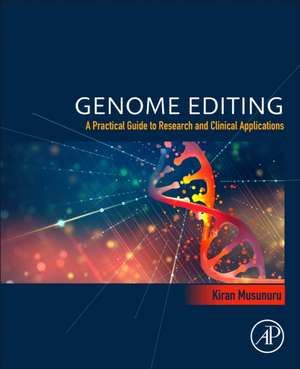Genome Editing: A Practical Guide to Research and Clinical Applications
Autor Kiran Musunuruen Limba Engleză Paperback – 9 mar 2021
- Help readers familiarise with the variety of genome-editing approaches that are being applied in cardiovascular research and medicine, i.e., both research applications and clinical applications
- Understand the use of genome editing through worked examples (based on real-life experiments) in which CRISPR-Cas9 is employed, online tools to design CRISPR-Cas9 reagents, methods to interpret data from genome-editing experiments, the downsides of genome-editing technology - both the scientific and ethical pitfalls to avoid
- Written in an easy-to-follow manner, guiding readers from the design of the project to its completion
- Includes unpublished and new methods
Preț: 737.67 lei
Preț vechi: 967.30 lei
-24% Nou
Puncte Express: 1107
Preț estimativ în valută:
141.20€ • 153.42$ • 118.68£
141.20€ • 153.42$ • 118.68£
Carte tipărită la comandă
Livrare economică 14-28 aprilie
Preluare comenzi: 021 569.72.76
Specificații
ISBN-13: 9780128234846
ISBN-10: 0128234849
Pagini: 230
Ilustrații: 75 illustrations (25 in full color)
Dimensiuni: 191 x 235 x 18 mm
Editura: ELSEVIER SCIENCE
ISBN-10: 0128234849
Pagini: 230
Ilustrații: 75 illustrations (25 in full color)
Dimensiuni: 191 x 235 x 18 mm
Editura: ELSEVIER SCIENCE
Public țintă
Investigators/researchers in cardiovascular research. (from trainees to principal investigators), clinicians, cardiologists. Investigators broadly engaged in biomedical research, advanced undergraduate, graduate students, educators and course developers who seek to stimulate interest in emerging research applications, college instructors/ professors teaching seminars on emerging research approaches. Those interested in ethics and health policy as they seek to understand the approach and applications well enough to make health policy recommendationsCuprins
1. Basic principles of genome editing2. Choosing a target site and editing strategy3. Choosing a nuclease, guide RNA, and repair template4. Assessing for off-target mutagenesis5. Assessing the outcomes of genome editing6. Base editing and other advanced forms of genome editing7. Epigenome editing8. Cellular disease modeling and risk prediction9. Functional experiments and screens10. Therapeutic applications11. Ethical implications
